GPU-Accelerated Infill Criterion for Multi-Objective Efficient Global Optimization Algorithm and Its Applications
Abstract
:1. Introduction
2. Related Works
2.1. Traditional Single-Objective EGO Algorithm
2.2. EHVI Infill Criterion for the Multi-Objective EGO Algorithm
3. Novel Approach to Computing Infill Criteria for MOEGO
3.1. A Brief Description of the Monte Carlo Approach
| Algorithm 1. MCHVI algorithm |
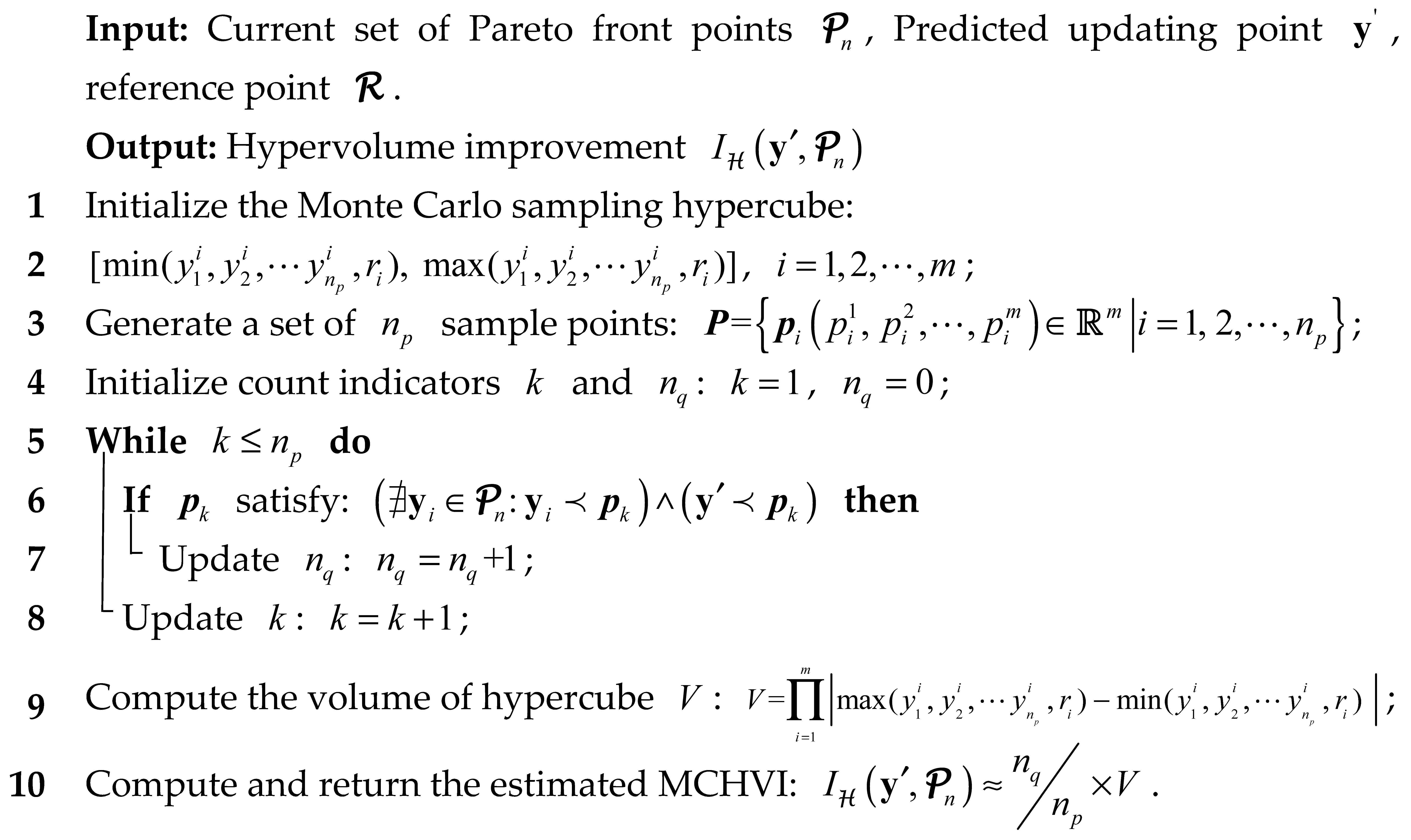 |
3.2. GPU-Accelerated Infill Criterion for the MOEGO Algorithm
| Algorithm 2. Code snippet of the kernel for GPU-based MCHVI calculation |
| 1 attributes(global) subroutine kernel_MCHV(MCSP_d, Front_d, HV_d) 2 i = (blockIdx%x-1)*blockDim%x + threadIdx%x !thread Index 3 4 do j = 1, nFront !loop over all Pareto front points and updating point 5 if(isInvalid(MCSP_d(:,i),Front_d(:,j)) return !judge of domination 6 end do 7 8 istat = atomicadd(HV_d, 1) !accumulate result to global memory 9 end subroutine |
| Algorithm 3. Code snippet of the CPU subroutine for calling |
| 1 subroutine calKernel_MCHV(MCSP, Front, HV) 2 NTPB = 64 !Number of threads per block 3 NBPG = ceiling(MCSP/64) ! Number of blocks per grid 4 5 MCSP_d = MCSP; Front_d = Front !Copy data to GPU 7 8 call kernel_MCHV <<<NBPG,NTPB>>> (MCSP_d,Front_d,HV_d) !call the kernel 9 10 HV = HV_d !Send result back to CPU 11 end subroutine |
3.3. Multi-Objective EGO Method with Modified Infill Criterion
| Algorithm 4. GMOEGO Algorithm | |
| Step 1 | Initialization: Use the DOE method to generate a set of sample points within design space, and evaluate their objective values of (for definition of , see Section 2.1). |
| Step 2 | Updating Model: Construct Kriging surrogate models based on current sample points for each objective. |
| Step 3 | Nondominated sort: Sort the current sample points by nondominated strategy to obtain the current set of Pareto front point . |
| Step 4 | Searching for Optimal Updating Point: Based on the Kriging models constructed, search for the optimal updating location by maximizing the EHVI indicator (Equation (11)) based on the Kriging models constructed, in which the indicator is calculated based on the Monte Carlo approach on a GPU computational platform. |
| Step 5 | Objective Function Evaluation: Calculate the values of objective functions at the optimal updating location obtained in Step 4 to update the sample values to obtain . |
| Step 6 | Stopping criterion: Check the stopping criterion. If satisfied, output the optimized Pareto front points and stop; if not, go back to Step 2. |
4. Numerical Tests and Analysis
4.1. Analysis of GPU Speedup Effect
4.2. Numerical Tests of the GMOEGO Algorithm
5. Aerodynamic Design Optimization
6. Conclusions
Author Contributions
Funding
Institutional Review Board Statement
Informed Consent Statement
Data Availability Statement
Conflicts of Interest
Appendix A
| Name | Number of Objectives | Number of Variables | Function | Constraints |
| ZDT1 | 2 | 2, 10 | ||
| ZDT2 | 2 | 10 | ||
| ZDT3 | 2 | 10 | ||
| DTLZ2 | 3 | 5 | ||
| DTLZ5 | 3 | 8 | ||
| DTLZ7 | 3 | 10 |
References
- Jones, D.R.; Schonlau, M.; Welch, W.J. Efficient Global Optimization of Expensive Black-Box Functions. J. Glob. Optim. 1998, 13, 455–492. [Google Scholar] [CrossRef]
- Emmerich, M.T.M.; Giannakoglou, K.C.; Naujoks, B. Single- and multiobjective evolutionary optimization assisted by Gaussian random field metamodels. IEEE Trans. Evol. Comput. 2006, 10, 421–439. [Google Scholar] [CrossRef]
- Forrester, A.I.J.; Keane, A.J. Recent advances in surrogate-based optimization. Prog. Aerosp. Sci. 2009, 45, 50–79. [Google Scholar] [CrossRef]
- Deng, F.; Qin, N.; Liu, X.; Yu, X.; Zhao, N. Shock control bump optimization for a low sweep supercritical wing. Sci. China Technol. Sci. 2013, 56, 2385–2390. [Google Scholar] [CrossRef]
- Xu, S.; Chen, H. Nash game based efficient global optimization for large-scale design problems. J. Glob. Optim. 2018, 71, 361–381. [Google Scholar] [CrossRef]
- Whitley, D. A genetic algorithm tutorial. Stat. Comput. 1994, 4, 65–85. [Google Scholar] [CrossRef]
- Sóbester, A.; Leary, S.J.; Keane, A.J. On the Design of Optimization Strategies Based on Global Response Surface Approximation Models. J. Glob. Optim. 2005, 33, 31–59. [Google Scholar] [CrossRef] [Green Version]
- Horowitz, B.; Guimarães, L.J.d.N.; Dantas, V.; Afonso, S.M.B. A concurrent efficient global optimization algorithm applied to polymer injection strategies. J. Pet. Sci. Eng. 2010, 71, 195–204. [Google Scholar] [CrossRef]
- Han, Z.-H.; Görtz, S.; Zimmermann, R. Improving variable-fidelity surrogate modeling via gradient-enhanced Kriging and a generalized hybrid bridge function. Aerosp. Sci. Technol. 2013, 25, 177–189. [Google Scholar] [CrossRef]
- Chung, I.-B.; Park, D.; Choi, D.-H. Surrogate-based global optimization using an adaptive switching infill sampling criterion for expensive black-box functions. Struct. Multidiscip. Optim. 2018, 57, 1443–1459. [Google Scholar] [CrossRef]
- Xu, S.; Chen, H.; Zhang, J. A study of Nash-EGO algorithm for aerodynamic shape design optimizations. Struct. Multidiscip. Optim. 2019, 59, 1241–1254. [Google Scholar] [CrossRef]
- Knowles, J. ParEGO A hybrid algorithm with on-line landscape approximation for expensive multiobjective optimization problems. IEEE Trans. Evol. Comput. 2006, 10, 50–66. [Google Scholar] [CrossRef]
- Keane, A.J. Statistical Improvement Criteria for Use in Multiobjective Design Optimization. AIAA J. 2006, 44, 879–891. [Google Scholar] [CrossRef]
- Liu, W.; Zhang, Q.; Tsang, E.; Liu, C.; Virginas, B. On the Performance of Metamodel Assisted MOEA/D. In ISICA 2007: Advances in Computation and Intelligence; International Symposium on Intelligence Computation and Applications; Kang, L., Liu, Y., Zeng, S., Eds.; Springer: Berlin/Heidelberg, Germany, 2007; Volume 4683, pp. 547–557. [Google Scholar]
- Namura, N.; Shimoyama, K.; Obayashi, S. Expected Improvement of Penalty-Based Boundary Intersection for Expensive Multiobjective Optimization. IEEE Trans. Evol. Comput. 2017, 21, 898–913. [Google Scholar] [CrossRef]
- Qingfu, Z.; Wudong, L.; Tsang, E.; Virginas, B. Expensive Multiobjective Optimization by MOEA/D With Gaussian Process Model. IEEE Trans. Evol. Comput. 2010, 14, 456–474. [Google Scholar] [CrossRef]
- Zitzler, E.; Thiele, L. Multiobjective optimization using evolutionary algorithms—A comparative case study. In Parallel Problem Solving from Nature—PPSN V; Lecture Notes in Computer Science; Eiben, A.E., Bäck, T., Schoenauer, M., Schwefel, H.-P., Eds.; Springer: Berlin/Heidelberg, Germany, 1998; Volume 1498, pp. 292–301. [Google Scholar]
- Emmerich, M.T.M. Single- and Multi-objective Evolutionary Design Optimization Assisted by Gaussian Random Field Metamodels. Ph.D. Thesis, University of Dortmund, Dortmund, Germany, 2005. [Google Scholar]
- Emmerich, M.; Beume, N.; Naujoks, B. An EMO Algorithm Using the Hypervolume Measure as Selection Criterion. In The Third International Conference on Evolutionary Multi-Criterion Optimization, Berlin, Heidelberg; Evolutionary Multi-Criterion Optimization; Springer: Berlin/Heidelberg, Germany, 2005; pp. 62–76. [Google Scholar]
- Ponweiser, W.; Wagner, T.; Biermann, D.; Vincze, M. Multiobjective Optimization on a Limited Budget of Evaluations Using Model-Assisted S-Metric Selection. In Parallel Problem Solving from Nature—PPSN X; Springer: Berlin/Heidelberg, Germany, 2008; pp. 784–794. [Google Scholar]
- Fleischer, M. The Measure of Pareto Optima Applications to Multi-objective Metaheuristics. In Evolutionary Multi-Criterion Optimization; Springer: Berlin/Heidelberg, Germany, 2003; pp. 519–533. [Google Scholar]
- Wagner, T.; Emmerich, M.; Deutz, A.; Ponweiser, W. On Expected-Improvement Criteria for Model-based Multi-objective Optimization. In Parallel Problem Solving from Nature, PPSN XI; Springer: Berlin/Heidelberg, Germany, 2010; pp. 718–727. [Google Scholar]
- Yang, K.; Deutz, A.H.; Yang, Z.; Back, T.; Emmerich, M. Truncated expected hypervolume improvement: Exact computation and application. In Congress on Evolutionary Computation; Springer: Berlin/Heidelberg, Germany, 2016; pp. 4350–4357. [Google Scholar]
- Li, Z.; Wang, X.; Ruan, S.; Li, Z.; Shen, C.; Zeng, Y. A modified hypervolume based expected improvement for multi-objective efficient global optimization method. Struct. Multidiscip. Optim. 2018, 58, 1961–1979. [Google Scholar] [CrossRef]
- Yang, K.; Emmerich, M.; Deutz, A.; Bäck, T. Multi-Objective Bayesian Global Optimization using expected hypervolume improvement gradient. Swarm Evol. Comput. 2019, 44, 945–956. [Google Scholar] [CrossRef]
- Zitzler, E. Evolutionary Algorithms for Multiobjective Optimization Methods and Applications. Ph.D. Thesis, Swiss Federal Institute of Technology, Zürich, Switzerland, 1999. [Google Scholar]
- Beume, N.; Rudolph, G. Faster S-Metric Calculation by Considering Dominated Hypervolume as Klee’s Measure Problem. In Proceedings of the Second IASTED International Conference on Computational Intelligence, San Francisco, CA, USA, 20–22 November 2006; pp. 233–238. [Google Scholar]
- While, L.; Hingston, P.; Barone, L.; Huband, S. A Faster Algorithm for Calculating Hypervolume. IEEE Trans. Evol. Comput. Optim. Appl. 2006, 10, 29–38. [Google Scholar] [CrossRef] [Green Version]
- Bradstreet, L.; While, L.; Barone, L. A Fast Incremental Hypervolume Algorithm. IEEE Trans. Evol. Comput. 2008, 12, 714–723. [Google Scholar] [CrossRef] [Green Version]
- Bader, J.; Zitzler, E. HypE An algorithm for fast hypervolume-based many-objective optimization. Evol. Comput. 2011, 19, 45–76. [Google Scholar] [CrossRef]
- Yang, K.; Emmerich, M.; Deutz, A.; Bäck, T. Efficient Computation of Expected Hypervolume Improvement Using Box Decomposition Algorithms. J. Glob. Optim. 2019, 75, 3–34. [Google Scholar] [CrossRef] [Green Version]
- Krige, D.G. A statistical approach to some basic mine valuation problems on the Witwatersrand. J. South Afr. Inst. Min. Metall. 1951, 52, 119–139. [Google Scholar]
- Sekishiro, M.; Venter, G.; Balabanov, V. Combined Kriging and Gradient-Based Optimization Method. In Proceedings of the 11th AIAA/ISSMO Multidisciplinary Analysis and Optimization Conference, Portsmouth, VA, USA, 6–8 September 2006; p. AIAA 2006-7091. [Google Scholar]
- Jiang, S.; Zhang, J.; Ong, Y.S.; Zhang, A.N.; Tan, P.S. A Simple and Fast Hypervolume Indicator-Based Multiobjective Evolutionary Algorithm. IEEE Trans. Cybern. 2015, 45, 2202–2213. [Google Scholar] [CrossRef] [PubMed]
- Hammersley, J.M.; Handscomb, D.C.; Weiss, G. Monte Carlo Methods. Phys. Today 1965, 18, 55. [Google Scholar] [CrossRef]
- Evans, M.; Swartz, T. Approximating Integrals via Monte Carlo and Deterministic Methods; OUP Oxford: Oxford, UK, 2000. [Google Scholar]
- Luo, C.; Shimoyama, K.; Obayashi, S. Kriging Model Based Many-Objective Optimization with Efficient Calculation of Expected Hypervolume Improvement. In Proceedings of the 2014 IEEE Congress on Evolutionary Computation (CEC), Beijing, China, 6–11 July 2014. [Google Scholar]
- Feng, D. Research on Efficient Global Optimization Algorithm and Its Application. Ph.D. Thesis, Nanjing University of Aeronautics and Astronautics, Nanjing, China, 2011. [Google Scholar]
- Ma, Z.; Wang, H.; Pu, S. GPU computing of compressible flow problems by a meshless method with space-filling curves. J. Comput. Phys. 2014, 263, 113–135. [Google Scholar] [CrossRef] [Green Version]
- Zhang, J.; Chen, H.; Cao, C. A graphics processing unit-accelerated meshless method for two-dimensional compressible flows. Eng. Appl. Comput. Fluid Mech. 2017, 11, 526–543. [Google Scholar] [CrossRef] [Green Version]
- Zhang, J.-L.; Ma, Z.-H.; Chen, H.-Q.; Cao, C. A GPU-accelerated implicit meshless method for compressible flows. J. Comput. Phys. 2018, 360, 39–56. [Google Scholar] [CrossRef] [Green Version]
- NVIDIA. CUDA C++ Programming Guide, Version 10. 2010. Available online: https://docs.nvidia.com/cuda/cuda-c-programming-guide/index.html (accessed on 8 September 2022).
- Kenny, Q.Y.; Li, W.; Sudjianto, A. Algorithmic construction of optimal symmetric Latin hypercube designs. J. Stat. Plan. Inference 2000, 90, 145–159. [Google Scholar]
- Deb, K.; Thiele, L.; Laumanns, M.; Zitzler, E. Scalable Test Problems for Evolutionary Multi-Objective Optimization. In Evolutionary Multiobjective Optimization. Advanced Information and Knowledge Processing; Abraham, A., Jain, L., Goldberg, R., Eds.; Springer: London, UK, 2005. [Google Scholar]
- Zhang, Q.; Li, H. MOEA/D: A multiobjective evolutionary algorithm based on decomposition. IEEE Trans. Evol. Comput. 2007, 11, 712–731. [Google Scholar] [CrossRef]
- Zhang, X.S.; Liu, J.; Luo, S.B. An improved multi-objective cuckoo search algorithm for airfoil aerodynamic shape optimization design. Hangkong Xuebao/Acta Aeronaut. Et Astronaut. Sinica 2018, 40, 5. [Google Scholar]
- Hicks, R.M.; Henne, P.A. Wing design by numerical optimization. J. Aircr. 1978, 15, 407–412. [Google Scholar] [CrossRef]
- Economon, T.D.; Palacios, F.; Copeland, S.R.; Lukaczyk, T.W.; Alonso, J.J. SU2: An open-source suite for multiphysics simulation and design. AIAA J. 2016, 54, 828–846. [Google Scholar] [CrossRef]

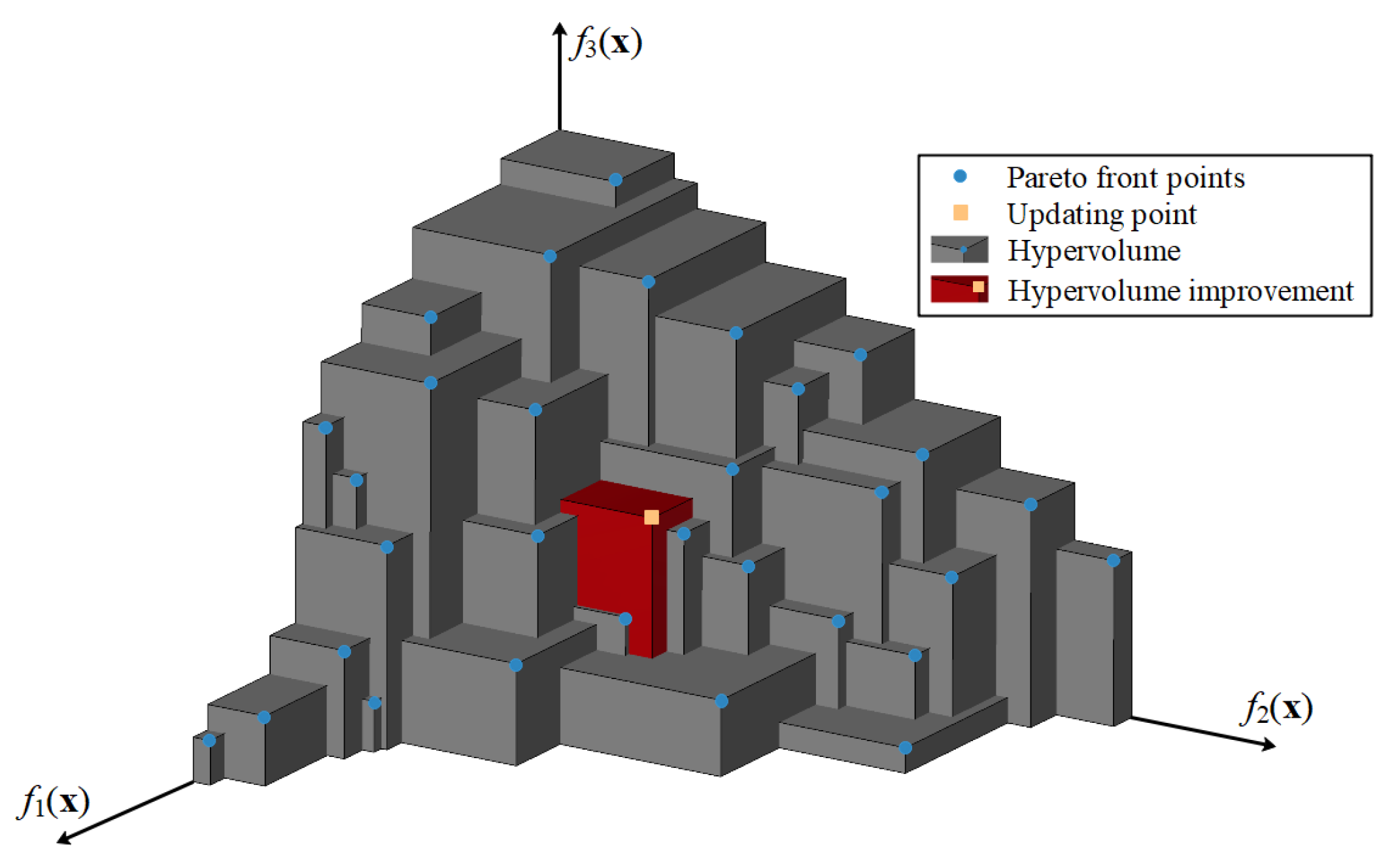
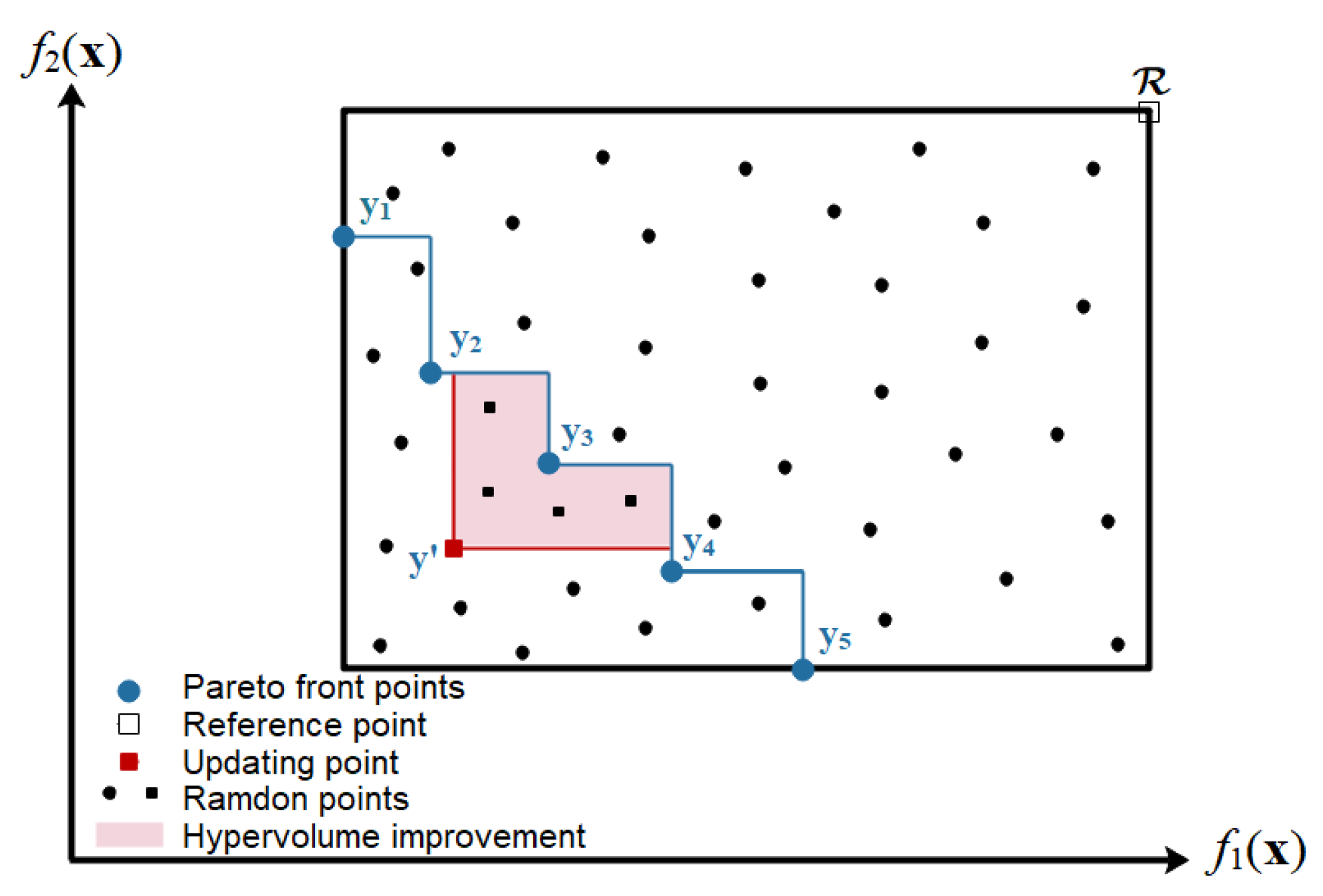
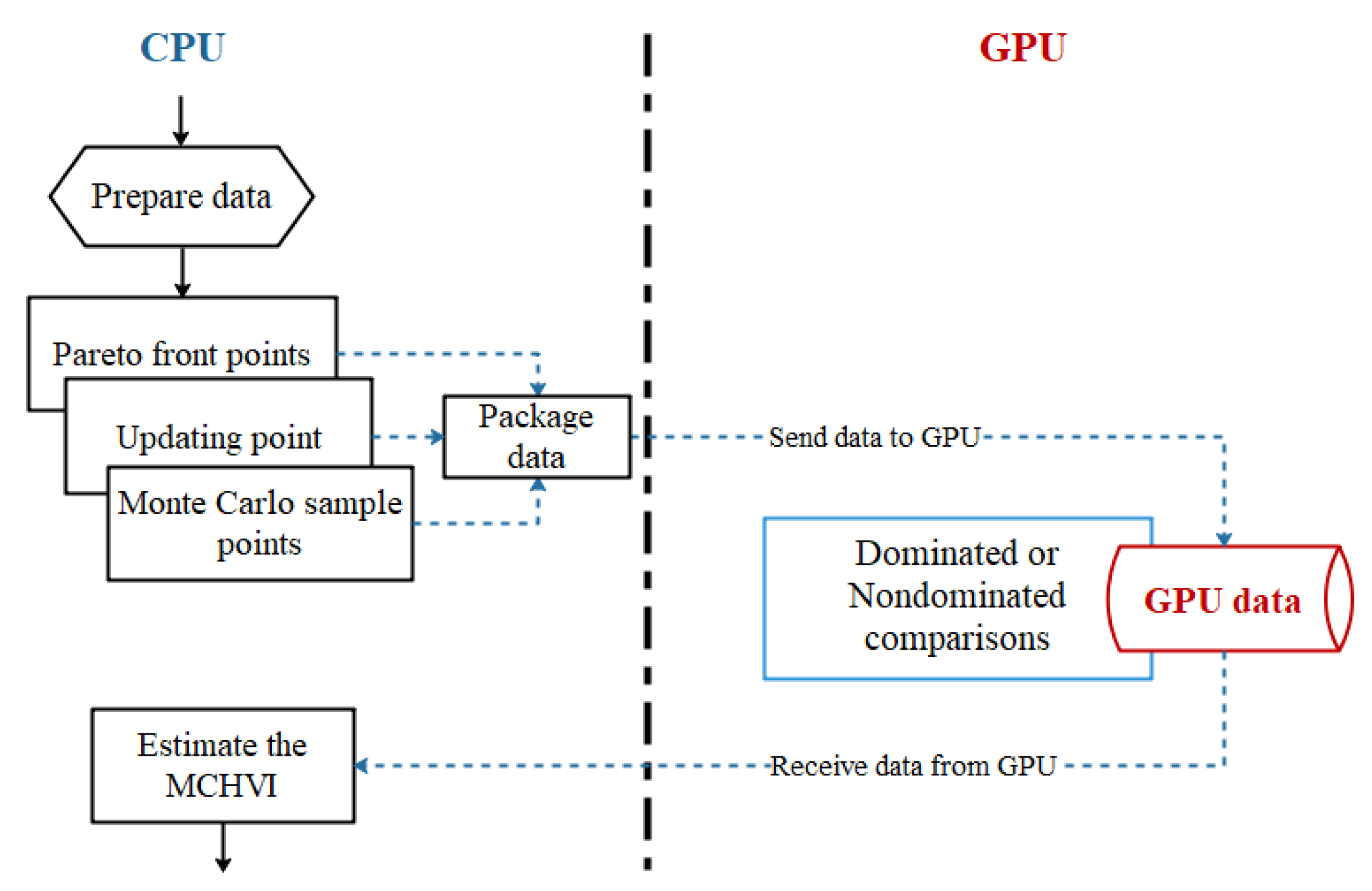




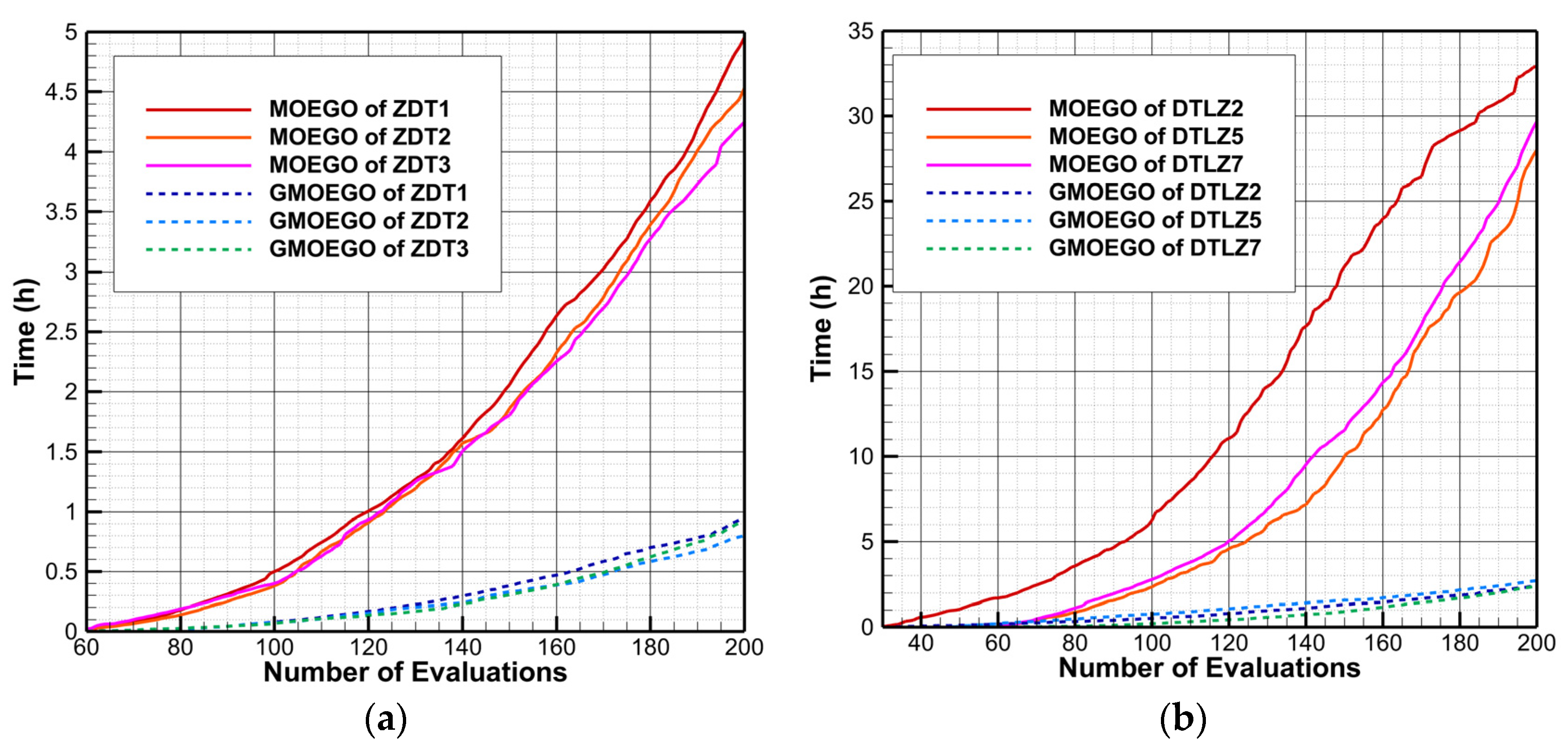
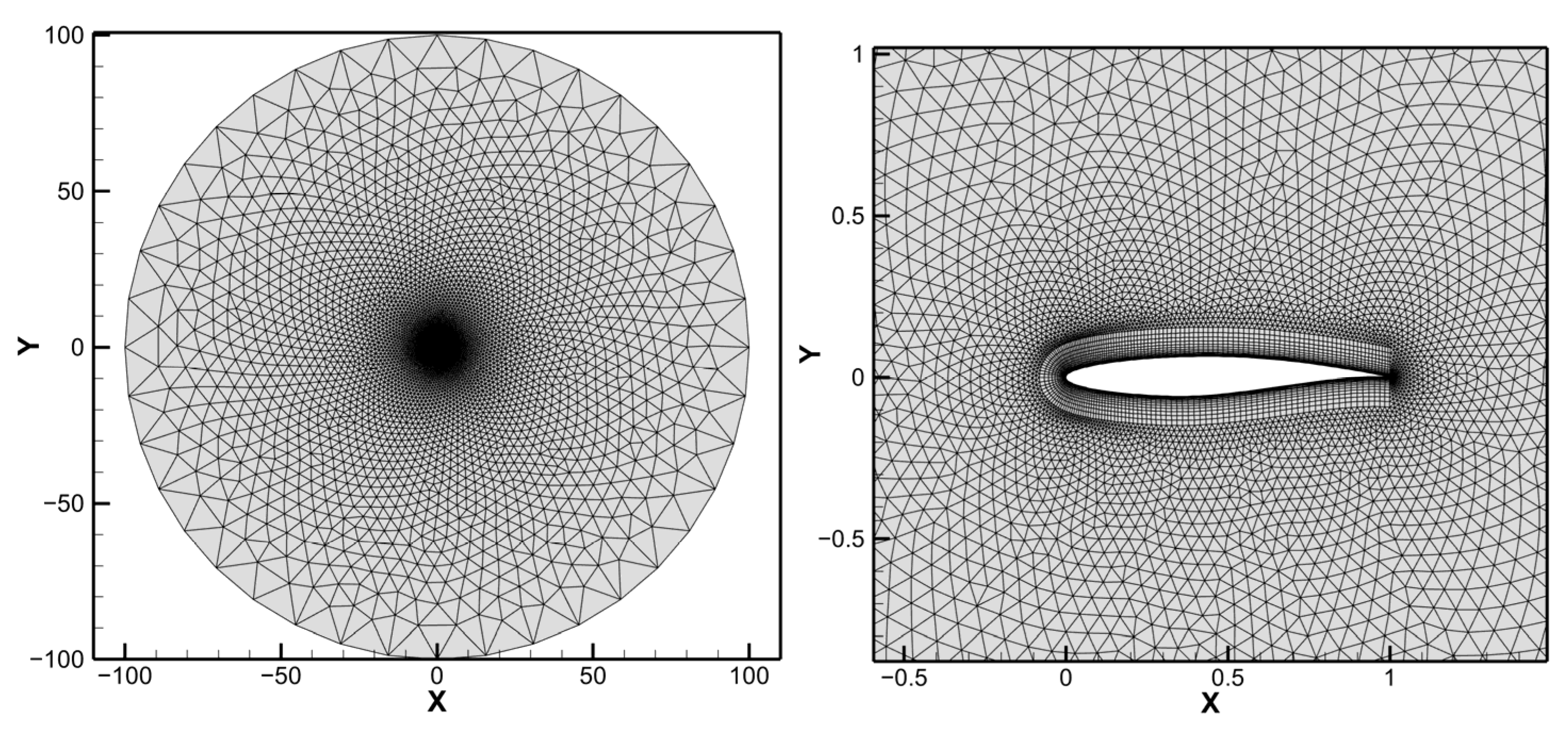

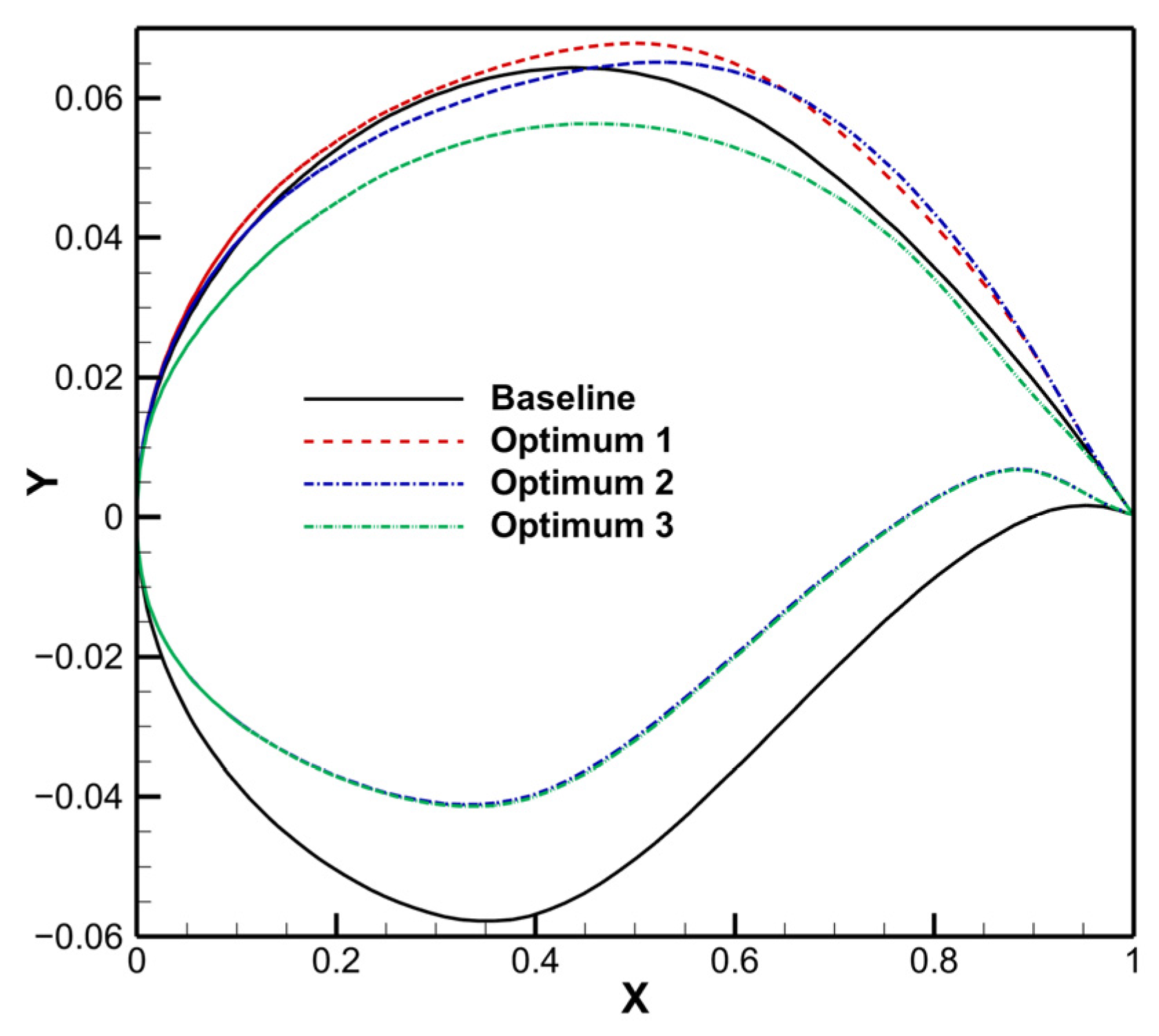
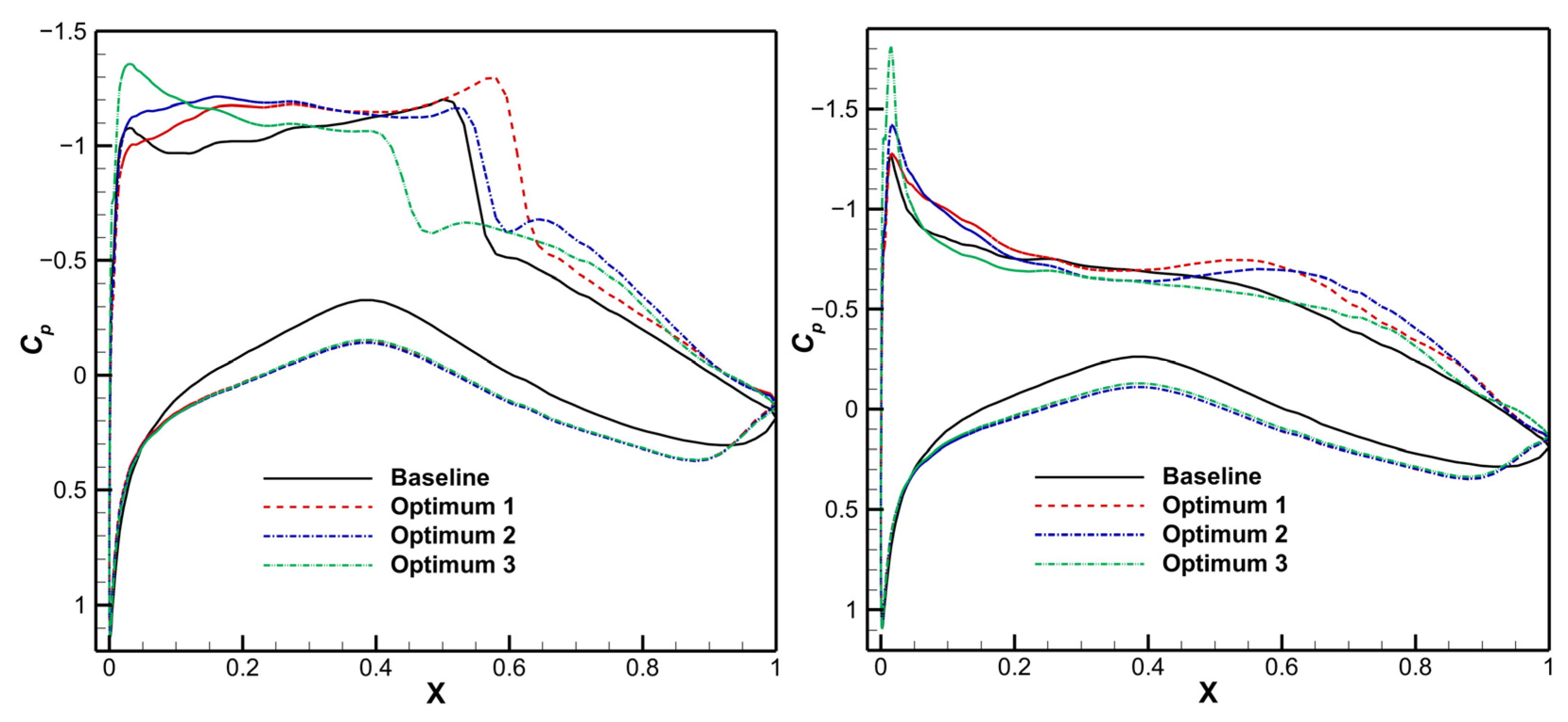
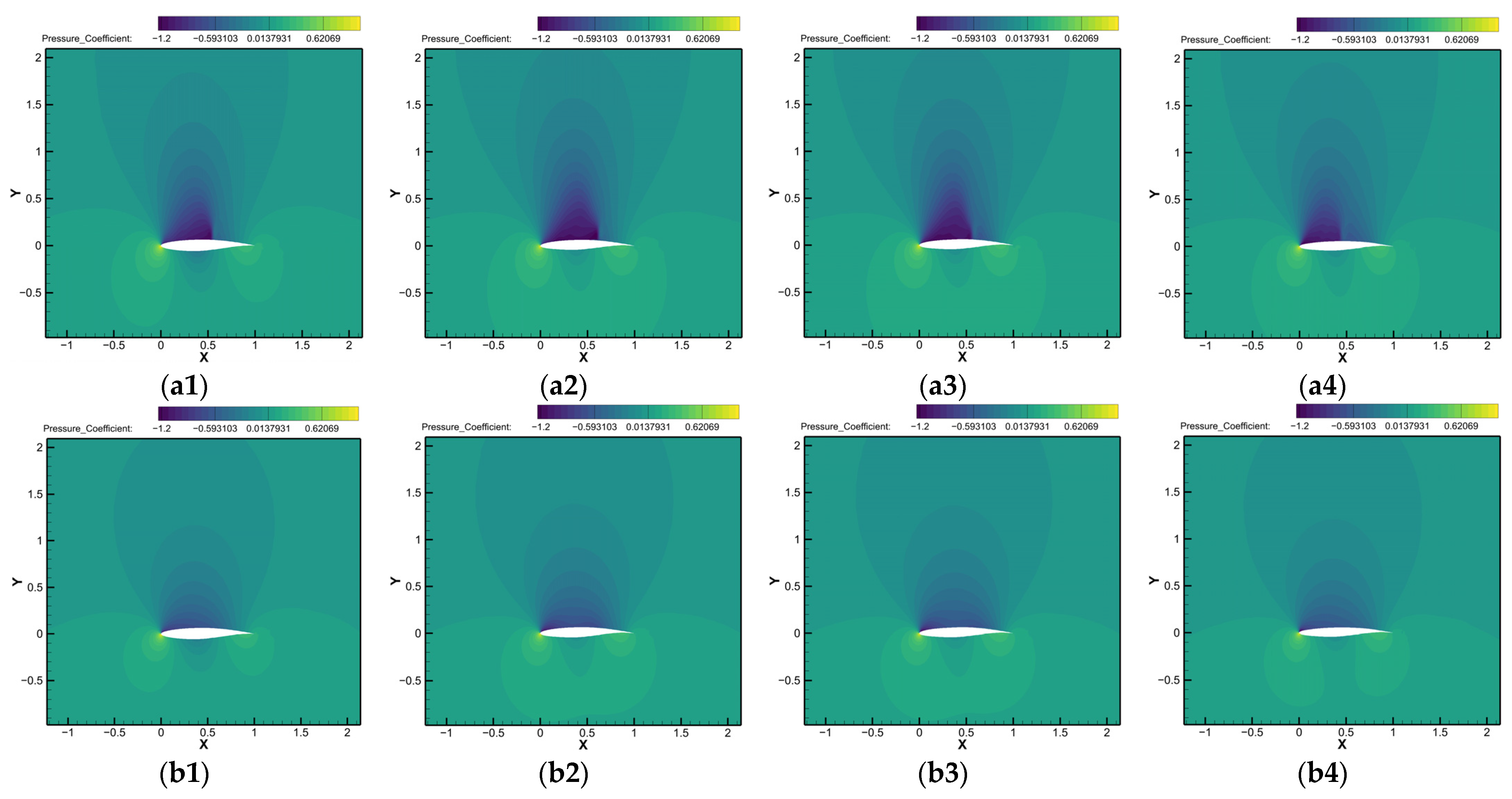
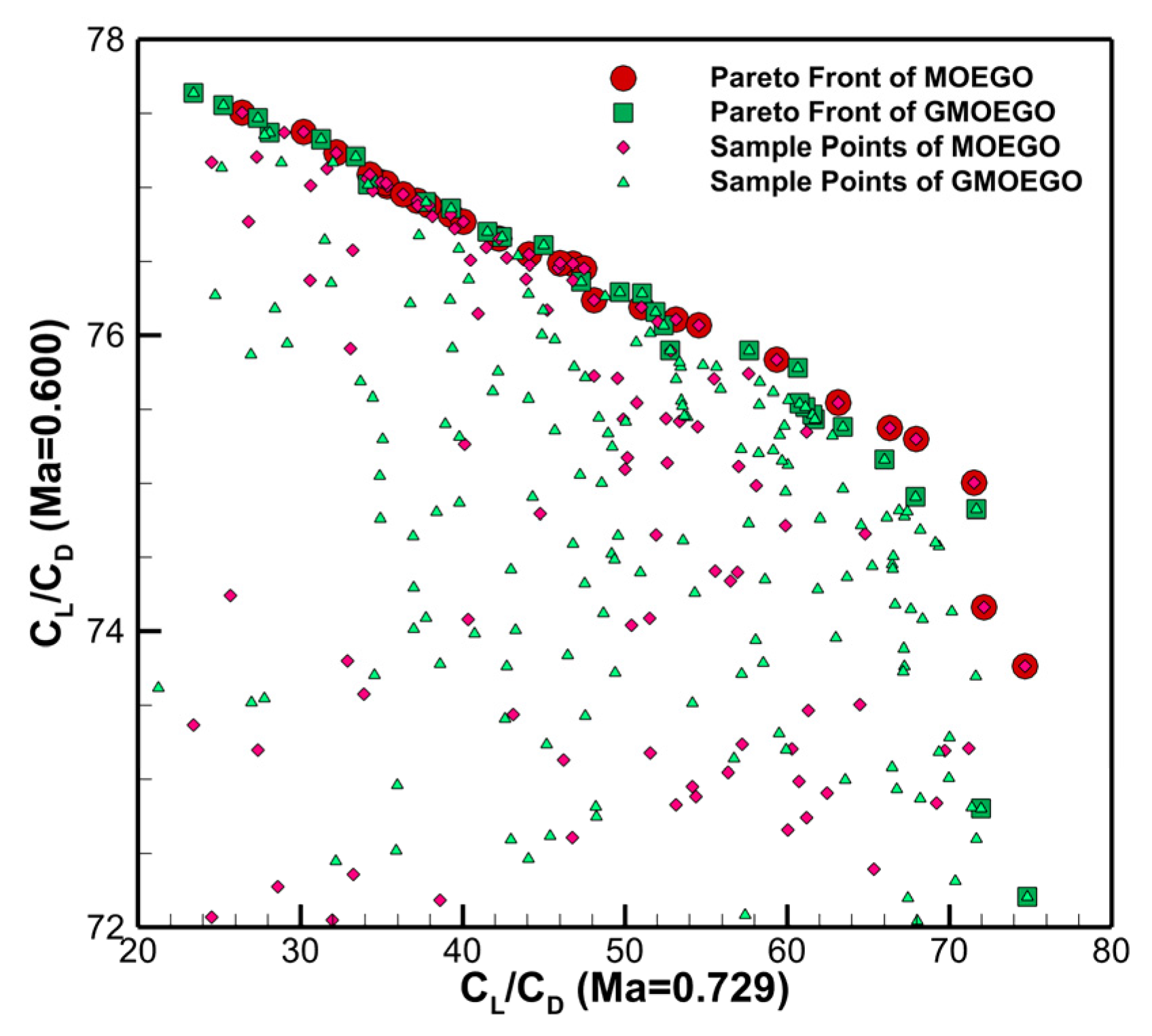
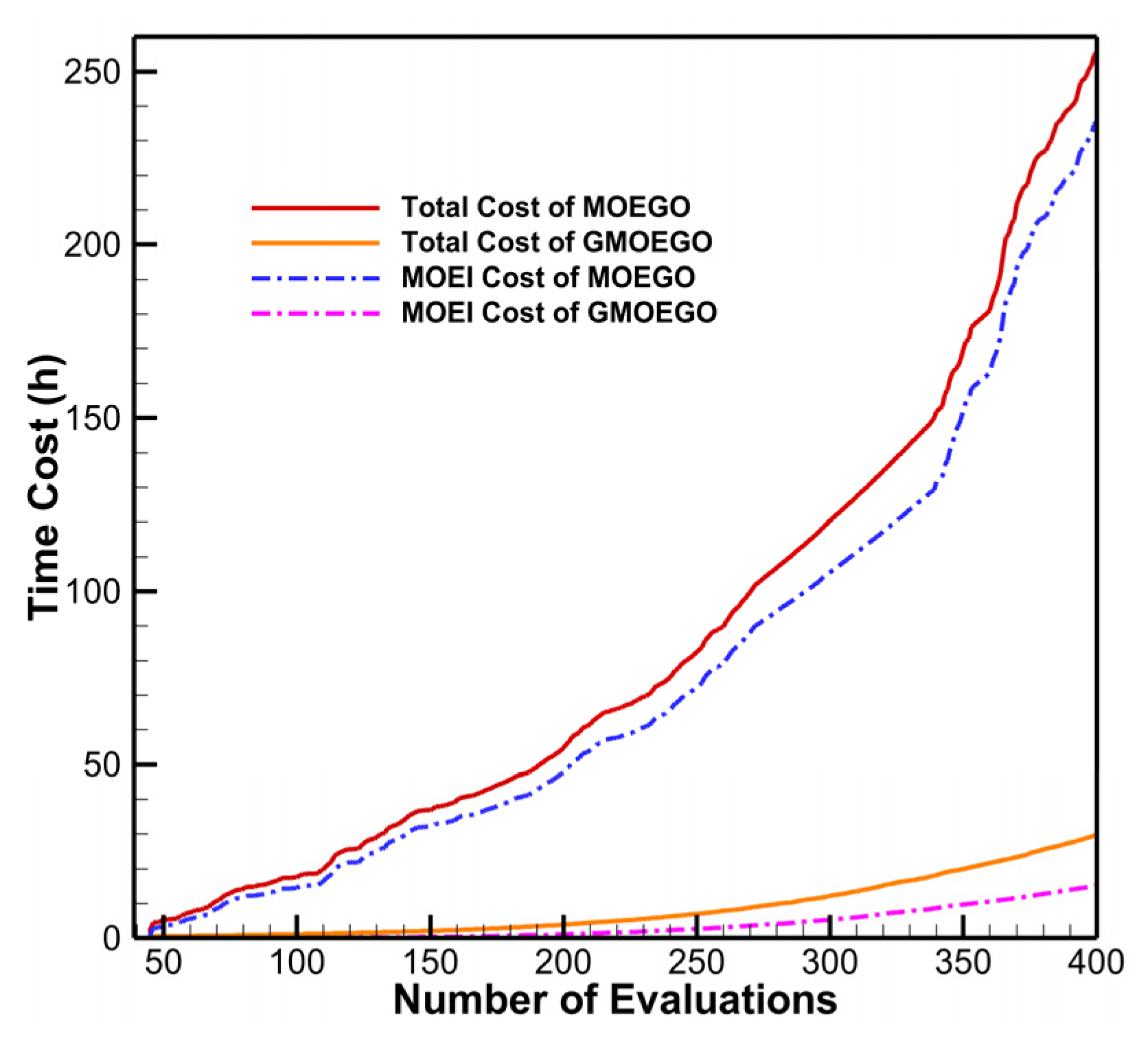
| Number of Monte Carlo Sample Points | Algorithm | Total Cost (Hours) | MCHVI Cost (Hours) | SUR of Total Cost (Times) |
|---|---|---|---|---|
| MOEGO | 0.239 | 0.001 | 0.916 | |
| GMOEGO | 0.261 | 0.018 | ||
| MOEGO | 0.253 | 0.010 | 0.920 | |
| GMOEGO | 0.275 | 0.032 | ||
| MOEGO | 0.403 | 0.169 | 1.404 | |
| GMOEGO | 0.287 | 0.051 | ||
| MOEGO | 2.146 | 1.893 | 5.896 | |
| GMOEGO | 0.364 | 0.124 | ||
| MOEGO | 28.081 | 27.830 | 12.575 | |
| GMOEGO | 2.233 | 1.986 |
| Test Function | Algorithm | IGD | Total Cost (Hours) | MCHVI Cost (Hours) | SUR of Total Cost (Times) |
|---|---|---|---|---|---|
| ZDT1 | MOEGO | 4.952 | 4.511 | 5.246 | |
| GMOEGO | 0.944 | 0.703 | |||
| ZDT2 | MOEGO | 5.247 | 4.530 | 6.559 | |
| GMOEGO | 0.800 | 0.601 | |||
| ZDT3 | MOEGO | 4.249 | 2.474 | 4.634 | |
| GMOEGO | 0.917 | 0.636 | |||
| DTLZ2 | MOEGO | 32.943 | 32.843 | 13.734 | |
| GMOEGO | 2.397 | 2.365 | |||
| DTLZ5 | MOEGO | 28.014 | 26.138 | 11.906 | |
| GMOEGO | 2.353 | 2.272 | |||
| DTLZ7 | MOEGO | 29.679 | 27.426 | 12.408 | |
| GMOEGO | 2.392 | 2.183 |
| Airfoil | Number of Objective | |
|---|---|---|
| Baseline | 1 | 53.81 |
| 2 | 61.86 | |
| Optimum 1 | 1 | 57.65 (+7.14%) |
| 2 | 75.90 (+22.57%) | |
| Optimum 2 | 1 | 67.94 (+26.26%) |
| 2 | 74.91 (+21.10%) | |
| Optimum 3 | 1 | 74.82 (+39.04%) |
| 2 | 72.21 (+16.73%) |
| Algorithm | Platform | Total Cost (Hours) | MCHVI Cost (Hours) | SUR of Total Cost (Times) |
|---|---|---|---|---|
| MOEGO | Intel Core i9-9900k CPU (with 8 cores in parallel) | 255.78 | 235.69 | 7.27 |
| GMOEGO | GTX-1066 | 35.20 | 17.13 |
Disclaimer/Publisher’s Note: The statements, opinions and data contained in all publications are solely those of the individual author(s) and contributor(s) and not of MDPI and/or the editor(s). MDPI and/or the editor(s) disclaim responsibility for any injury to people or property resulting from any ideas, methods, instructions or products referred to in the content. |
© 2022 by the authors. Licensee MDPI, Basel, Switzerland. This article is an open access article distributed under the terms and conditions of the Creative Commons Attribution (CC BY) license (https://creativecommons.org/licenses/by/4.0/).
Share and Cite
Xu, S.; Zhang, J.; Chen, H.; Gao, Y.; Gao, Y.; Gao, H.; Jia, X. GPU-Accelerated Infill Criterion for Multi-Objective Efficient Global Optimization Algorithm and Its Applications. Appl. Sci. 2023, 13, 352. https://doi.org/10.3390/app13010352
Xu S, Zhang J, Chen H, Gao Y, Gao Y, Gao H, Jia X. GPU-Accelerated Infill Criterion for Multi-Objective Efficient Global Optimization Algorithm and Its Applications. Applied Sciences. 2023; 13(1):352. https://doi.org/10.3390/app13010352
Chicago/Turabian StyleXu, Shengguan, Jiale Zhang, Hongquan Chen, Yisheng Gao, Yunkun Gao, Huanqin Gao, and Xuesong Jia. 2023. "GPU-Accelerated Infill Criterion for Multi-Objective Efficient Global Optimization Algorithm and Its Applications" Applied Sciences 13, no. 1: 352. https://doi.org/10.3390/app13010352
APA StyleXu, S., Zhang, J., Chen, H., Gao, Y., Gao, Y., Gao, H., & Jia, X. (2023). GPU-Accelerated Infill Criterion for Multi-Objective Efficient Global Optimization Algorithm and Its Applications. Applied Sciences, 13(1), 352. https://doi.org/10.3390/app13010352






